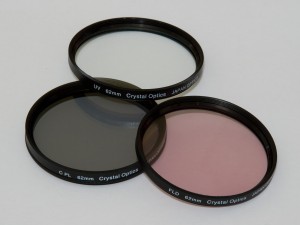It's always hard to choose a good filter for your expensive lenses. Sometimes it's harder than choosing a good camera or the best lens. But it is obvious that using a bad filters or low quality filters will have an adverse effect on the quality of your photographs. But if you use good quality filters, there shouldn't be a much noticeable effect on the picture quality. There are different varieties of filters available for digital cameras. But the question is which filter do you want to use and for what purpose? I have seen few photographers use the filter to colorize the picture. But in this day and age, I don't see any point using filters to color the picture. Digital camera already comes with a lot of features to colorize your picture. You can also use a White Balance technique or even software to modify the colors settings during the post-processing.
There are few types of filters which are popular for the digital camera. And they are Polarizing Filter, UV Filter, Neutral Density Filters, Graduated Neutral Density Filters, Filters for Infrared effects etc. Now the point is you have to be clear on what you want your filters to do with your photographs?
Lens Filter for DSLR Camera
Normally, polarizing filters are used to reduce the glare and reflections from the surfaces and also very popular while shooting a bright sky to make comparatively dark and deep blue sky. Polarizing filters help to increase the contrast on colorful subjects and enrich the colors in your images. UV filters are used to avoid an ultra violet ray from the sunlight which can produce unpleasant colors to the photographs. However, some photographers use it to protect the front element of their expensive lenses from scratches and sands or small stones that may come up during the shooting. Neutral Density filters are used to reduce the overall exposure of the image uniformly throughout the frame without affecting the colors. And the Graduated Neutral Density filters (where the top part of the filter is coated to make it dark and the bottom part is clear) are popular to shoot the landscape where you want to darken the sky and keep the foreground exposure unaltered. There are two types of Graduated ND filters; hard edge (where the transition of the dark part and the clear part is immediate making it suitable for seascape) and the soft edge (where the transition of the dark part and the soft edge is gradual making it suitable for sunrise or sunset where the horizon is not leveled in a straight line).
If you are thinking of using the filters, multicoated filter is a far better option than a single coated filter or uncoated filter. And most importantly, don't use the cheap filters. Using the cheap filters will certainly degrade the quality of the picture and in that case it is far better to shoot without using one.
Currently I am using Hoya UV filter for my 18-200mm VR II lens attached on my Nikon D90. This filter ring is designed to fit your lens cap very well without removing it which I liked very much. I have shot many pictures using Hoya UV filters and haven't had any issue with the picture quality so far. Nikon also produces filters which are bit expensive but might worth the money.





